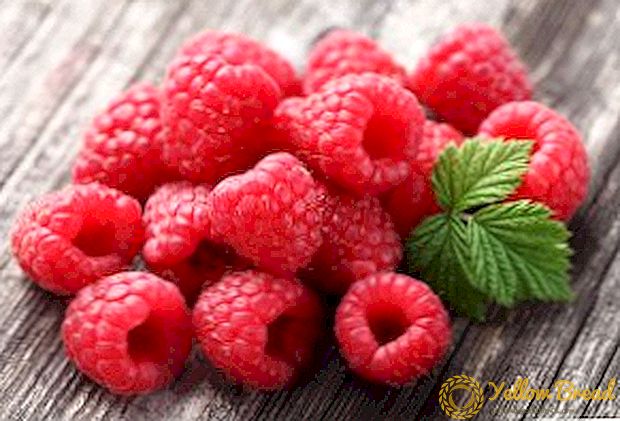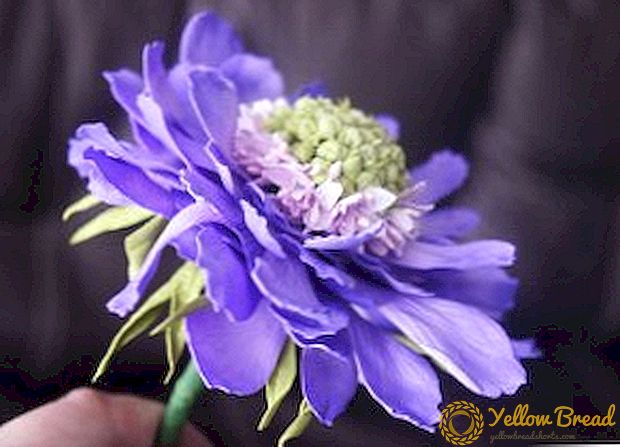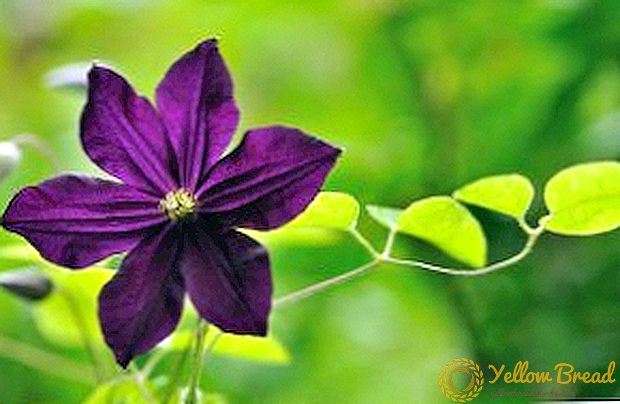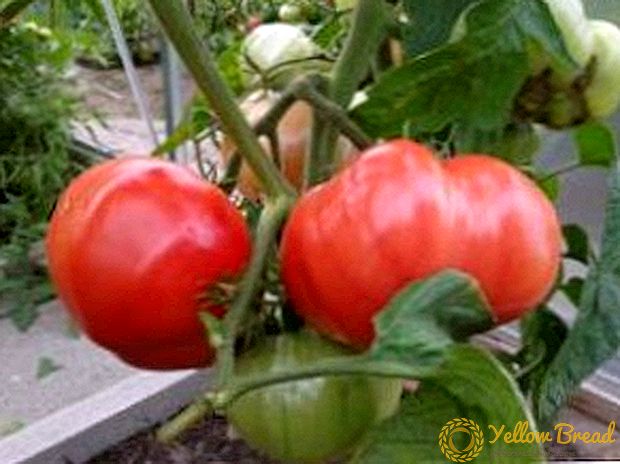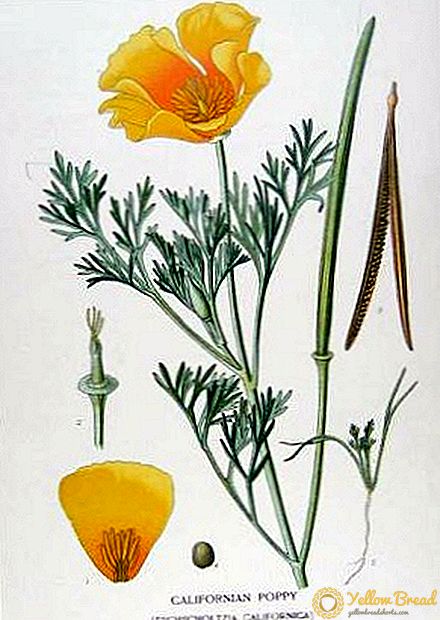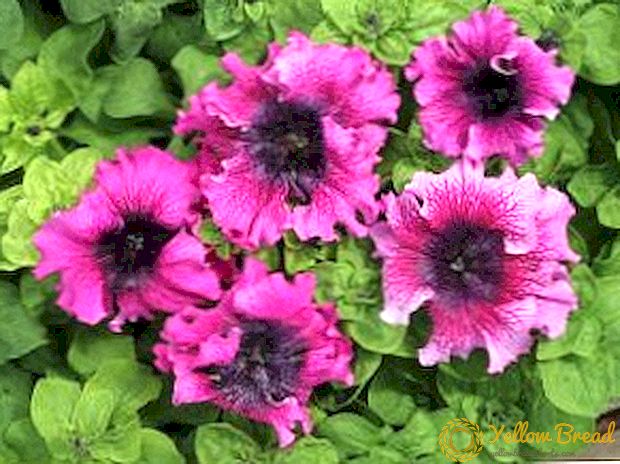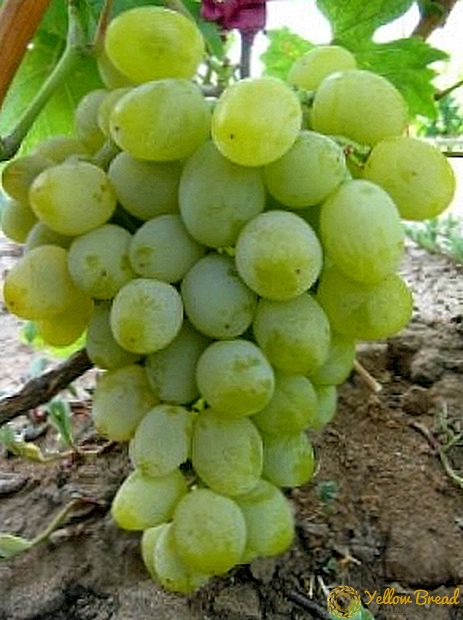
Earlier, about 50 years ago, it was not possible to grow grapes in the north.
Now, with the development of selection science, people are creating more resistant to weathering varieties.
This variety is also a sort of "Harold", which is gaining popularity not only due to its taste, but also because of its unpretentiousness to weather conditions.
Consider more precisely the "Harold".
Description of the grape variety "Harold"

Variety of table grapes "Harold" was obtained by crossing varieties "Delight", "Arcadia" and "Muscat summer." "Harold" ripens very quicklyfor 95 - 100 days. You can taste the berries in the middle - end of July. In addition, the clusters can not be removed until mid-September without loss of presentation and changes in taste.
Bushes vigorous, clusters of medium size (0.4 - 0.5 kg), cylindric conical shape, with an average density. The berries are ellipsoid with a pointed end (23x20 mm), with a mass of 6 - 7 g. The skin is yellow - green, dense, juicy flesh.
The taste is very pleasant, acid and sweetness are in balance. From the Harold grape I make Muscat wines, because the berries of this variety have a refined muscatel smell.The yield is very high, one bush brings about 15 kg of berries. Resistance to mildew and oidium is high. Harold can withstand temperatures down to -25 C.
Grapes are well transported. A feature of the Harold grape is a double crop, which is obtained by fruiting the main shoots and stepsons.
Merits:
- great taste and aroma
- high disease resistance
- good transportability
- short ripening
- high frost resistance
There are no flaws in this variety.
About the features of planting this variety

The variety "Harold" is not whimsical to the soil, therefore, it is possible to plant bushes of this particular grape on any land. These grapes are quite vigorous, therefore it is necessary to plant bushes at least at a distance of 3 m from each other.
Due to high performance frost resistanceYou can drop the Harold seedlings both in spring and in autumn. The main requirement is the temperature mark above 15 ° С. if you buy a sapling, then you need to be very careful in choosing. If the seedling has more than 4 thick enough and long roots and there is no damage of any kind, then buy such a cutting immediately without hesitation.
If the sapling broke during bending, or there are traces of diseases on it, then a healthy and fruiting shrub will not grow from such an embryo.
Before landing you need shorten one-year runawayon which there should be 4 - 5 ocelli. During the day - two before planting need to lower the seedling into the water. It is also desirable to add growth stimulants to the water.
For each seedling, a hole is dug in dimensions of 80x80x80 cm. When digging, the top layer of soil needs to be set aside, and later mixed with humus / compost / peat, superphosphate and potassium salt. Such a mixture should occupy about half the depth of each pit. Further, the seedling is placed in the recesses with a “heel”, slightly sprinkled with the mixture, and longer completely filled with ordinary earth.
After planting and watering, the earth should be loosened and covered with mulch.
Tips on caring for a variety
- Watering

“Harold” normally tolerates both a small drought and an excess of moisture. Therefore, watering the bushes of this variety is standard.The standard moisture application is that the grapes are watered from April to October.
The first watering is done in early spring, after the opening of the bushes after winter. Next is important water the grapes while budding and before flowering, because it is then that the bushes need the greatest amount of moisture for the entire growing season.
During flowering, watering can not be done, because the bushes themselves will suffer from this by shedding flowers. When clusters have already formed on the bush, soil moisture will not be superfluous.
The last watering - moisture charging - is performed right before the shelter of the bushes for the winter. On average, the volume of water that should go to 1 bush, is about 40 - 50 liters. But for water recharge irrigation, the volume should be increased to 70 liters per bush so that the water goes deep enough.
For proper irrigation, either a drainage system is installed, or several circular trenches are made near the bush at a distance of at least 30 cm. Water is poured into these trenches 20 cm deep.
- Mulching
To preserve moisture in the soil longer cover with mulch. Mulch is somewhat similar to organic fertilizer, but performs a different function.
Peat, humus, straw, old fallen leaves, mowed grass can be used as a necessary material. Today, there are many special materials that perfectly protect the roots of grapes from dehydration, but also prevent the development of weeds and improve aeration.
- Harboring
"Harold" is a very cold-resistant variety, but still in conditions of our harsh winters requires shelter.
The most popular way to protect grapes in winter is shelter polyethylene.
To do this, each vine vine is tied, laid on the ground and secured. Then, over the entire grape row, iron arcs are set, on which the plastic film will stretch. You can, of course, stretch the two layers, but “Harold” does not need this.
In addition to polyethylene shelter, you can still lay the vines laid on the ground with plenty of earth. But first, before laying the shoots on the ground, something needs to be laid. Otherwise, the process of decay will begin.
- Pruning
One of the features of the "Harold" variety is double-fruiting, that is, not only the main shoots, but also the stepchildren can bear fruit (step-son = escape on the shoot).But for this you need to remove all the extra inflorescences on the secondary shoots, they must remain a total of 20 pieces. on 1 bush.
Also "Harold" characteristic overload bushestherefore, every year it is necessary to shorten the young shoots, leaving about 30 - 35 eyes on a bush.
- Fertilizer

When planting, a fertile mixture was introduced into the pit, so it is not necessary to fertilize the saplings for 4 years after planting.
For adult bushes mineral fertilizers are important. Therefore, every year before you release the bush from protection for the winter, and before the flowering begins, you need to make a whole range of fertilizers, that is, nitrogen, phosphorus and potassium. Such top dressing is done in the form of a solution; the ratio of superphosphate, ammonium nitrate and potassium salt to each 10 l of water is 2: 1: 0.5, respectively.
Before the clusters ripen, do not need to make ammonium nitrate. And if winter is coming, then you need feed the bushes with potassium. Organics need to make 1 time in 2 - 3 years. Poultry dung, compost, rotted manure and other agricultural waste are suitable for the role of such fertilizers.
- Protection
Despite the fact that Harold is not damaged by mildew and oidium, as a preventive measure, it is possible to treat the bushes before flowering with fungicides that contain phosphorus, or with a 1% solution of Bordeaux mixture.

